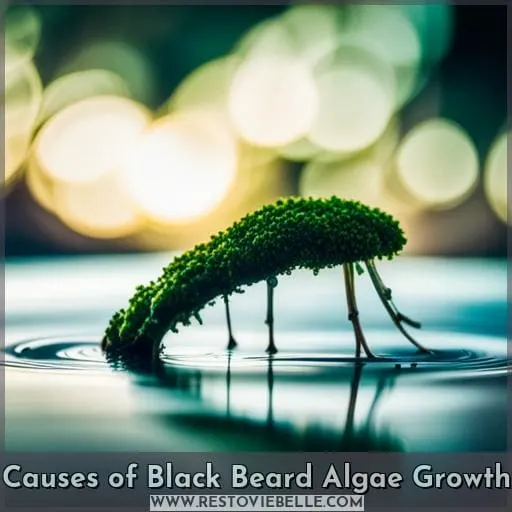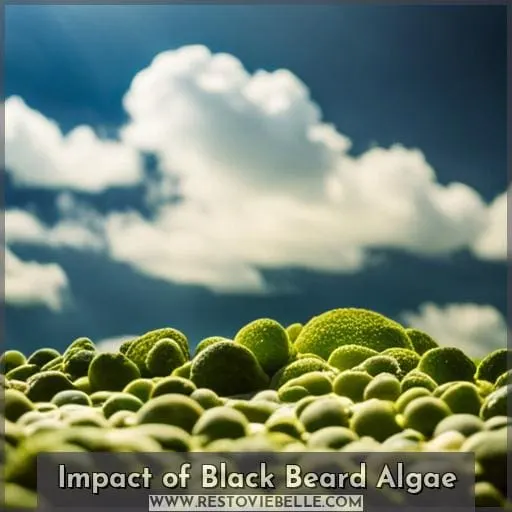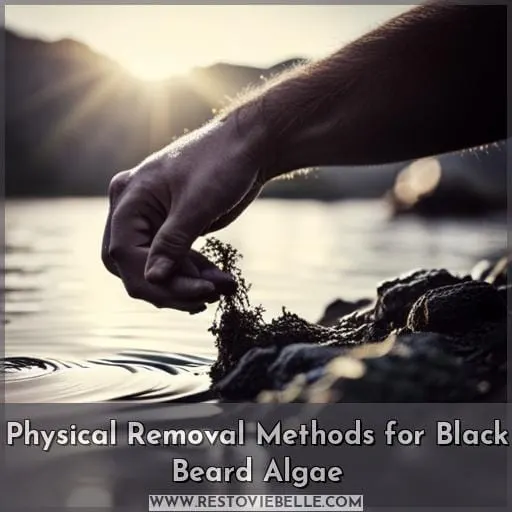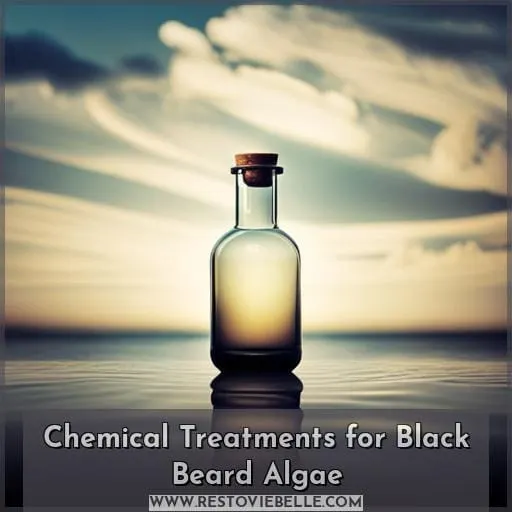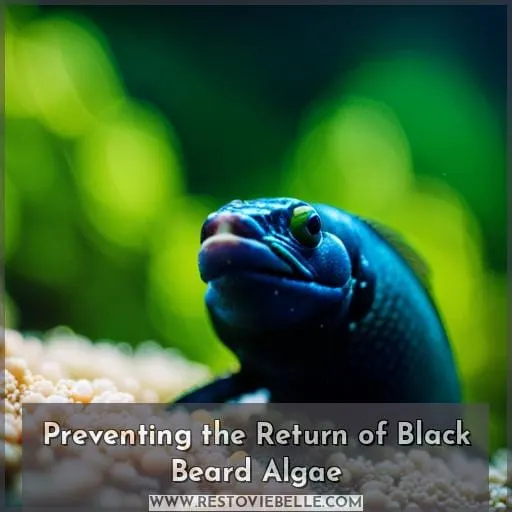This site is supported by our readers. We may earn a commission, at no cost to you, if you purchase through links.
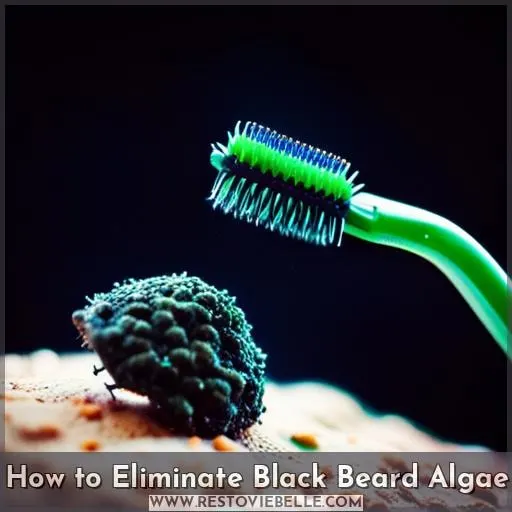 Imagine a black algae that resembles a scruffy beard, lurking in your aquarium. This pesky intruder is none other than Black Beard Algae (BBA).
Imagine a black algae that resembles a scruffy beard, lurking in your aquarium. This pesky intruder is none other than Black Beard Algae (BBA).
It may surprise you to learn that despite its name and appearance, BBA is actually a member of the red algae family.
But fear not! In this article, we will guide you on how to eliminate this bearded menace from your tank using effective removal methods and preventive measures.
Say goodbye to Black Beard Algae once and for all!
Table Of Contents
- Key Takeaways
- What is Black Beard Algae?
- Causes of Black Beard Algae Growth
- Impact of Black Beard Algae
- Physical Removal Methods for Black Beard Algae
- Chemical Treatments for Black Beard Algae
- Biological Control of Black Beard Algae
- Preventing the Return of Black Beard Algae
- The Role of Nutrients in Black Beard Algae Growth
- Quarantine and Sterilization Practices
- Frequently Asked Questions (FAQs)
- Can black beard algae harm fish or other aquatic life in the aquarium?
- How long does it typically take for black beard algae to engulf an aquarium if left unchecked?
- Are there any specific plants that should be avoided when using liquid carbon treatments for black beard algae?
- How long does it take for black beard algae to die after applying hydrogen peroxide?
- What are some online resources or communities where I can seek further advice on dealing with black beard algae?
- Conclusion
Key Takeaways
- Excess nutrients and low CO2 levels are common causes of black beard algae growth.
- Physical removal methods such as scrubbing affected areas and introducing algae-eating organisms can help get rid of black beard algae.
- Chemical treatments like using liquid carbon additives and applying a hydrogen peroxide solution can also be effective.
- Preventing the return of black beard algae involves maintaining optimal water parameters, practicing proper quarantine and sterilization, and regularly performing water changes.
What is Black Beard Algae?
Black Beard Algae (BBA), also referred to as Black Brush Algae due to its appearance resembling a scruffy black beard-like fuzz on various surfaces within an aquarium setting including driftwood decorations and live plants – is an unrelenting nuisance for many aquarists worldwide.
This resilient form of red algae thrives under nutrient imbalances caused by factors such as poor water parameter management practices combined with inadequate cleaning routines resulting in accumulations of waste material.
While this particular species poses no direct threat towards aquatic organisms residing within your tank’s ecosystem; if left untreated long enough – excessive growth may overshadow underwater flora blocking essential sunlight & vital nutrients thus diminishing their overall health leading ultimately toward death altogether.
In conclusion, preventive measures need implementation early on before any signs appear impeding further propagation afterwards through biological control methods involving introduction predators capable consuming BBA entirely eliminating concerns related forthcoming infestations future keeping your beloved pets safe healthy environment they call home!
Causes of Black Beard Algae Growth
Black Beard Algae (BBA) growth is primarily caused by an imbalance in the aquarium environment, resulting from excess nutrients.
Poor water quality, lack of maintenance, overdosing of fertilizers, fluctuating CO2 levels, and excessive light are all contributing factors.
Accumulated waste and organic matter also play a role in providing the necessary nutrients for BBA to thrive.
Nutrient imbalances and BBA
One of the main causes of Black Beard Algae (BBA) growth in aquariums is an imbalance in nutrients.
- Excess nutrients
- Low CO2 levels
- Fluctuating CO2 levels
- Excessive light exposure
- Poor water quality
Excess phosphates and inadequate CO2 levels provide favorable conditions for BBA growth. Inadequate water circulation can also contribute to nutrient buildup. Adding fast-growing plants like Java Ferns can help outcompete BBA for nutrients and prevent its proliferation.
Impact on aquarium plants
When Black Beard Algae grows on aquarium plants, it can hinder their growth and potentially suffocate them.
This unsightly algae blocks light from reaching the leaves of epiphyte plants, slowing down their growth and causing damage.
It can also choke the plants by attaching to them in high-flow areas.
To maintain healthy and thriving aquarium plants, it’s important to remove black algae promptly using effective methods that target its harmful effects.
Effective BBA removal methods
To effectively eliminate Black Beard Algae, you can employ various removal methods.
- Use liquid carbon additives like Seachem Excel or other Glutaraldehyde-based products to inhibit BBA growth.
- Spot treat affected areas with a 3% hydrogen peroxide solution.
- Introduce algae-eating fish such as Siamese Algae Eaters or Amano Shrimp.
- Maintain optimal CO2 levels and consistent lighting.
- Regularly physically remove BBA.
- Utilize a powerhead for better water circulation.
Impact of Black Beard Algae
Black Beard Algae can have a significant impact on the aesthetics and health of your aquarium plants.
This brownish gray algae, also known as BBA, isn’t harmful to fish or other aquatic life.
However, when it covers the leaves of your plants, it can block light and nutrients, potentially suffocating and killing them.
The color change of BBA from deep black to reddish or clear indicates that it’s dying off and becoming edible for algae-eating species in your tank.
It’s important to note that while BBA may resemble a fuzzy mess in your aquarium, it isn’t actually a plant itself but rather a type of red algae.
Therefore, taking action to eliminate Black Beard Algae will help restore the visual appeal and overall health of your planted tank without harming any fish or other inhabitants.
Physical Removal Methods for Black Beard Algae
To physically remove black beard algae, you can scrub affected areas using a toothbrush.
This method allows for precision in targeting the specific areas where the algae is growing.
By gently scrubbing the affected surfaces, you can dislodge and remove the black beard algae from your aquarium.
Scrubbing Affected Areas
To remove Black Beard Algae effectively, start by scrubbing the affected areas using a toothbrush or sponge.
Here’s what you need to know about scrubbing:
- Scrub with precision: Target specific areas where BBA is present.
- Find the right tools: A soft-bristled toothbrush or sponge works well for delicate cleaning.
- Maintain regularity: Increase scrubbing frequency until all traces of BBA are gone.
- Be cautious and patient: Scrub gently and consistently over a period of time for best results.
Using a Toothbrush for Precision
When dealing with black beard algae, one effective method for precise removal is to use a toothbrush.
Choose a toothbrush with medium hardness bristles that won’t damage delicate plants.
Adjust the angle of the toothbrush to reach all areas affected by black beard algae and apply gentle pressure while using short strokes to scrub away the algae.
Repeat this process regularly until all traces of black beard algae are gone from your aquarium.
Chemical Treatments for Black Beard Algae
Now let’s delve into the topic of chemical treatments for black beard algae.
There are several options available to effectively combat and eliminate this stubborn algae species from your aquarium.
These treatments include:
- Liquid carbon additives
- Hydrogen peroxide applications
- The introduction of algae-eating organisms
- Specialized commercial products designed specifically for black beard algae removal.
Liquid Carbon Additives
To eliminate Black Beard Algae, you can effectively utilize liquid carbon additives as a chemical treatment. When using liquid carbon for BBA, it’s important to follow safety precautions and dosing instructions carefully.
Here are three key points to consider when using liquid carbon additives:
- Ensure the efficacy of the product by choosing a trusted brand.
- Be aware of potential side effects on sensitive plants like vallisneria.
- Explore alternatives like hydrogen peroxide if needed.
[ADDITIONAL INFORMATION]:
Liquid Carbon Additives:
- Liquid carbon additives contain Glutaraldehyde, which inhibits and eliminates Black Beard Algae.
- These products are available in various concentrations and should be used according to dosing instructions provided by the manufacturer.
Safety Precautions:
- Always wear protective gloves when handling these chemicals.
- Avoid contact with skin or eyes; rinse immediately if accidental exposure occurs.
Dosing Instructions:
- Follow dosage recommendations specific to your aquarium size provided on the product label or accompanying documentation.
Side Effects:
- Some plant species may be more sensitive than others to liquid carbon treatments; monitor their reaction closely after application and adjust dosage accordingly.
Efficacy:
The effectiveness of liquid carbon treatments for eliminating Black Beard Algae varies depending on factors such as tank conditions, severity of infestation, and quality/dosage of the chosen product. It’s essential to maintain consistency in treatment application over time for optimal results.
Alternatives:
If you prefer not to use chemical treatments or want additional methods alongside them, hydrogen peroxide can also be effective against BBA growth when applied directly onto affected areas outside water while temporarily turning off filters during treatment (always follow proper guidelines).
Hydrogen Peroxide Application
Apply a 3% hydrogen peroxide solution directly on the Black Beard Algae (BBA) outside of water to effectively combat its growth.
The hydrogen peroxide concentration is important, as higher concentrations can harm aquatic life and plants.
Leave the solution on BBA for about 5 minutes before rinsing it off and returning it to the aquarium.
Be cautious when using hydrogen peroxide, as excessive application time or concentration can have negative side effects.
Consider alternatives or seek advice for safety precautions when using this method to control black beard algae in your aquariums.
Biological Control of Black Beard Algae
You can introduce algae-eating organisms to your aquarium as a natural way to control black beard algae. These species are known for their ability to consume BBA and help maintain a balanced ecosystem in your tank.
Here are some options you can consider:
- Siamese Algae Eaters: These fish are highly effective at consuming BBA and can make a significant impact on its growth.
- Florida Flagfish: Known for their appetite for black beard algae, these colorful fish can be an excellent addition to your aquarium.
- Amano Shrimp: While they may be slower compared to other species, Amano shrimp still contribute towards reducing the presence of BBA in your tank.
- Nerite Snails: These small snails have an impressive appetite for algae, including black beard algae.
By introducing these organisms into your aquarium, you create a more sustainable environment that helps control the growth of black beard algae naturally.
Emotion evoking unordered list:
- Liberation from the persistent presence of unsightly black beard algae
- Power over the situation by actively managing and controlling its growth
- Mastery achieved through implementing effective biological solutions
- Relief from tedious physical removal methods or harsh chemical treatments
- Confidence knowing that there are reliable allies in the fight against stubborn algal infestations
Preventing the Return of Black Beard Algae
To prevent the return of black beard algae, it’s crucial to maintain optimal water parameters and ensure good water circulation in your aquarium.
Maintaining stable conditions such as appropriate temperature, pH levels, and nutrient balance will discourage the growth of black beard algae.
Additionally, promoting proper water flow through adequate filtration and strategically placing powerheads or pumps can help prevent stagnant areas where algae can thrive.
Maintaining Optimal Water Parameters
To prevent the return of Black Beard Algae, maintain optimal water parameters in your aquarium.
- Consistently monitor and adjust pH levels, KH levels, CO2 levels, nitrate levels, and phosphate levels.
- Ensure proper surface agitation to maintain oxygenation and minimize CO2 issues.
- Avoid low PAR light conditions that can promote algae growth.
- Strive for a balanced ecosystem by addressing any imbalances in water parameters to keep Black Beard Algae at bay.
Ensuring Good Water Circulation
Maintaining good water circulation is crucial in preventing the return of black beard algae.
Proper water flow direction and rate help prevent stagnant areas where BBA can thrive.
Ensure there are no obstructions that impede water movement, such as overgrown plants or decorations.
Good water circulation has several benefits, including distributing nutrients evenly and discouraging algae growth.
However, excessive flow may stress fish and disturb delicate plants.
Finding the right balance is key to preventing the resurgence of black beard algae in freshwater tanks.
The Role of Nutrients in Black Beard Algae Growth
To promote the growth of Black Beard Algae (BBA) in your aquarium, it’s crucial to maintain a balance of nutrients.
Phosphate levels, nitrate levels, CO2 levels, light intensity, and water circulation all play significant roles in BBA growth.
Excessive phosphate and nitrate concentrations provide ample fuel for BBA’s rapid multiplication.
Insufficient CO2 can hinder plant growth while providing favorable conditions for BBA to thrive.
High light intensity without proper regulation can also contribute to excessive algae growth.
Additionally, stagnant areas with poor water circulation create ideal environments for black beard algae colonization due to nutrient accumulation.
By carefully monitoring and controlling these factors through regular testing and adjustments as needed, you can effectively prevent or mitigate the occurrence of black beard algae outbreaks in your aquarium.
Quarantine and Sterilization Practices
Before introducing new plants or decor into your aquarium, it’s crucial to practice proper quarantine and sterilization. This step helps prevent the introduction of Black Beard Algae (BBA) and other unwanted organisms into your tank.
When acquiring new plants or decorations, dip them in a bleach solution for about 2-3 minutes before rinsing thoroughly with clean water.
For old tanks that have been infested with BBA, cleaning filter media by soaking it in a bleach solution can help eliminate any spores or remnants of the algae.
Additionally, regularly performing water changes and maintaining proper heat levels will aid in preventing BBA growth.
Remember to avoid using soap when cleaning aquarium decorations as residue can harm aquatic life.
By following these practices diligently, you can ensure a healthier environment for your fish while keeping black beard algae at bay.
Frequently Asked Questions (FAQs)
Can black beard algae harm fish or other aquatic life in the aquarium?
Black beard algae (BBA) generally doesn’t harm fish or other aquatic life.
Its primary impact is on the aesthetics and health of aquarium plants, as it can block light and nutrients, potentially suffocating and killing them.
How long does it typically take for black beard algae to engulf an aquarium if left unchecked?
If left unchecked, black beard algae can engulf an aquarium within one to two years. Its rapid growth rate and ability to cover surfaces make it important to address promptly for a thriving tank.
Are there any specific plants that should be avoided when using liquid carbon treatments for black beard algae?
When using liquid carbon treatments for black beard algae, it’s important to avoid sensitive plants like vallisneria.
These plants can be harmed by the treatment, so exercise caution and choose appropriate alternatives.
How long does it take for black beard algae to die after applying hydrogen peroxide?
After applying hydrogen peroxide to black beard algae, it typically takes around five minutes for the algae to begin dying. During this time, the affected areas may turn red or clear before ultimately becoming edible.
What are some online resources or communities where I can seek further advice on dealing with black beard algae?
To seek further advice on dealing with black beard algae, you can explore online resources such as aquarium-related forums and communities.
Engage with experienced aquarists or experts, consult comprehensive articles and books, or visit your local fish store for specific solutions.
Conclusion
To bid farewell to the pesky bearded menace known as Black Beard Algae, follow these effective removal methods and preventive measures.
Scrub affected areas and use a toothbrush for precision in physically removing the algae.
Consider chemical treatments or biological control options for more stubborn cases.
Prevent the return of Black Beard Algae by maintaining optimal water parameters and ensuring good water circulation in your aquarium.
By understanding the role of nutrients and implementing quarantine and sterilization practices, you can eliminate Black Beard Algae from your tank once and for all.


